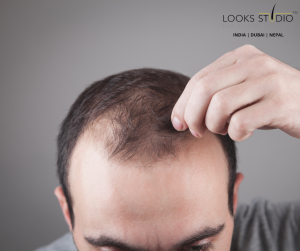Genetics and hair loss:
Baldness Gene from Mother or Father
Hair loss, specifically male and female pattern baldness, is influenced by a combination of genetic factors inherited from both parents. Contrary to a common myth, hair loss genes are not solely inherited from the mother’s side. Genetic susceptibility to hair loss can be inherited from either the mother or the father, or even both. This is because hair loss is influenced by a complex interplay of multiple genes.
Dominant or Recessive Genes
Genes associated with hair loss can exhibit either dominant or recessive traits. Dominant genes are more likely to express their traits, even if only one copy of the gene is present. Recessive genes, on the other hand, need both copies of the gene to carry the trait to manifest it. Male and female pattern baldness is often associated with a combination of genes, some of which may be dominant, while others are recessive. This complexity explains why some individuals experience hair loss more severely than others, even within the same family.
Recognizing Genetic Hair Loss
Genetic Hair Loss Symptoms
Genetic hair loss typically presents itself in specific patterns. In males, it commonly involves a receding hairline and thinning of the hair on the crown, creating the well-known “bald spot.” In females, it often leads to diffuse hair thinning all over the scalp. This gradual process occurs over an extended period, usually years.
Distinguishing Genetic Hair Loss from Other Factors
Distinguishing genetic hair loss from other factors, such as stress-related hair loss or hormonal imbalances, can be challenging. Stress, hormonal changes, and certain medical conditions can also contribute to hair thinning. Consulting a dermatologist or a healthcare professional is crucial to accurately diagnose the underlying cause of hair loss and develop an appropriate treatment plan.
Is Male Pattern Baldness X-Linked?
Explanation of X-Linked Inheritance
X-linked inheritance involves genes located on the X chromosome. In the context of male pattern baldness, the inheritance pattern is not solely X-linked. While genetics do play a role, the situation is more complex due to the involvement of multiple genes.
Natural Approaches to Address Genetic Hair Loss
Nutritional Strategies
Eating a well-balanced diet rich in vitamins and minerals can support overall hair health. Nutrients like biotin, vitamin D, iron, and zinc play crucial roles in promoting healthy hair growth. Antioxidants found in fruits and vegetables combat oxidative stress that can contribute to hair loss.
Scalp Care and Massage
Regular scalp massages can help improve blood circulation to the hair follicles. Massaging the scalp with natural oils, such as coconut or jojoba oil, can provide nutrients and hydration to the hair and scalp, potentially improving the condition of the hair.
Stress Management
Stress has been linked to hair loss, both through direct physiological mechanisms and as a trigger for behaviours that can lead to hair damage. Stress-reduction techniques like meditation, yoga, and deep breathing can help mitigate its impact on hair health.

Genetic Hair Loss Treatments
Over-the-Counter Treatments
Minoxidil3, available as a topical solution, is a common over-the-counter treatment for genetic hair loss. It works by increasing blood flow to the hair follicles, potentially promoting hair growth. Results vary among individuals, and consistent use is required to maintain any improvements.
Prescription Medications
Finasteride, a prescription medication, is commonly used to treat genetic hair loss in males. It works by inhibiting the conversion of testosterone2 into dihydrotestosterone (DHT)1, a hormone implicated in hair loss. However, it’s important to discuss potential side effects and risks with a healthcare provider.
Surgical Interventions
For individuals seeking more significant results, surgical options like hair transplantation can be considered. Techniques like follicular unit transplantation (FUT) and follicular unit extraction (FUE) involve moving hair follicles from donor areas to areas with thinning or no hair.
Bio Integrated FUE method which is patented by Looks Studio has brought in a great fusion between Medical science and technology. The advancement in the FUE method to the old conventional slit method endorsed the delivery as the 5 th generation and the latest method of Hair Transplant.
Seeking Professional Guidance
Dermatologist Evaluation
Consulting a dermatologist is essential for accurate diagnosis and personalized treatment plans. A dermatologist can assess the underlying causes of hair loss and recommend appropriate interventions based on individual needs. Book free appointment
Genetic Testing
Genetic testing is an emerging option that can help individuals understand their genetic susceptibility to hair loss. However, it’s important to approach genetic testing with caution, as it might not provide a complete picture of the complex factors contributing to hair loss.
Conclusion
Understanding the role of genetics in hair loss empowers individuals to make informed decisions about addressing their hair health. While genetics do play a significant role, various factors contribute to hair loss, and treatment approaches can vary based on individual circumstances. By seeking professional guidance and adopting a holistic approach to hair care, individuals can take steps to manage and potentially mitigate the impact of genetic hair loss.
